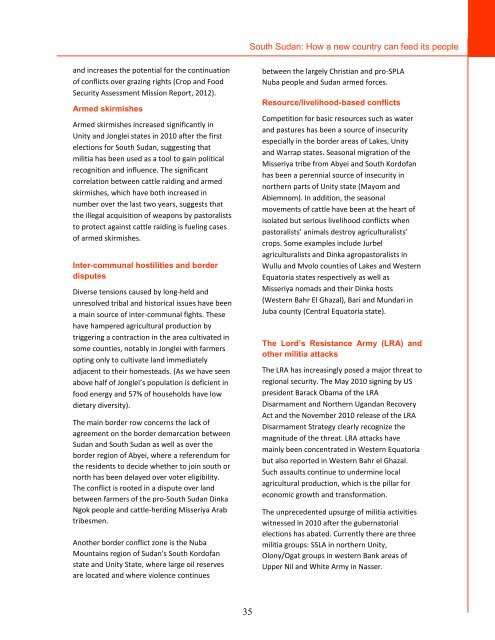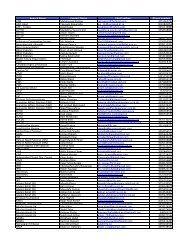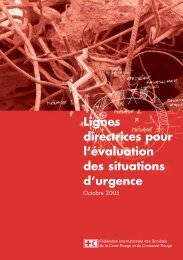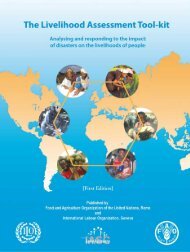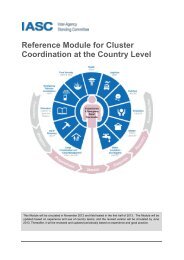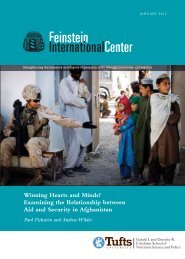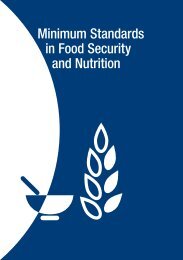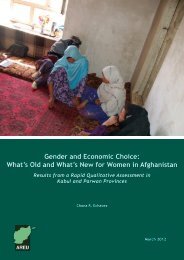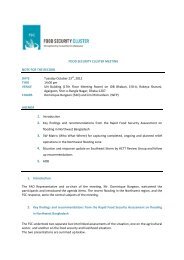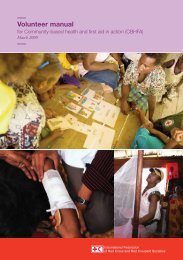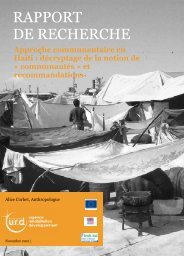4.15 MB - Food Security Clusters
4.15 MB - Food Security Clusters
4.15 MB - Food Security Clusters
- No tags were found...
Create successful ePaper yourself
Turn your PDF publications into a flip-book with our unique Google optimized e-Paper software.
South Sudan: How a new country can feed its peopleand increases the potential for the continuationof conflicts over grazing rights (Crop and <strong>Food</strong><strong>Security</strong> Assessment Mission Report, 2012).Armed skirmishesArmed skirmishes increased significantly inUnity and Jonglei states in 2010 after the firstelections for South Sudan, suggesting thatmilitia has been used as a tool to gain politicalrecognition and influence. The significantcorrelation between cattle raiding and armedskirmishes, which have both increased innumber over the last two years, suggests thatthe illegal acquisition of weapons by pastoraliststo protect against cattle raiding is fueling casesof armed skirmishes.Inter-communal hostilities and borderdisputesDiverse tensions caused by long-held andunresolved tribal and historical issues have beena main source of inter-communal fights. Thesehave hampered agricultural production bytriggering a contraction in the area cultivated insome counties, notably in Jonglei with farmersopting only to cultivate land immediatelyadjacent to their homesteads. (As we have seenabove half of Jonglei’s population is deficient infood energy and 57% of households have lowdietary diversity).The main border row concerns the lack ofagreement on the border demarcation betweenSudan and South Sudan as well as over theborder region of Abyei, where a referendum forthe residents to decide whether to join south ornorth has been delayed over voter eligibility.The conflict is rooted in a dispute over landbetween farmers of the pro-South Sudan DinkaNgok people and cattle-herding Misseriya Arabtribesmen.Another border conflict zone is the NubaMountains region of Sudan's South Kordofanstate and Unity State, where large oil reservesare located and where violence continuesbetween the largely Christian and pro-SPLANuba people and Sudan armed forces.Resource/livelihood-based conflictsCompetition for basic resources such as waterand pastures has been a source of insecurityespecially in the border areas of Lakes, Unityand Warrap states. Seasonal migration of theMisseriya tribe from Abyei and South Kordofanhas been a perennial source of insecurity innorthern parts of Unity state (Mayom andAbiemnom). In addition, the seasonalmovements of cattle have been at the heart ofisolated but serious livelihood conflicts whenpastoralists’ animals destroy agriculturalists’crops. Some examples include Jurbelagriculturalists and Dinka agropastoralists inWullu and Mvolo counties of Lakes and WesternEquatoria states respectively as well asMisseriya nomads and their Dinka hosts(Western Bahr El Ghazal), Bari and Mundari inJuba county (Central Equatoria state).The Lord’s Resistance Army (LRA) andother militia attacksThe LRA has increasingly posed a major threat toregional security. The May 2010 signing by USpresident Barack Obama of the LRADisarmament and Northern Ugandan RecoveryAct and the November 2010 release of the LRADisarmament Strategy clearly recognize themagnitude of the threat. LRA attacks havemainly been concentrated in Western Equatoriabut also reported in Western Bahr el Ghazal.Such assaults continue to undermine localagricultural production, which is the pillar foreconomic growth and transformation.The unprecedented upsurge of militia activitieswitnessed in 2010 after the gubernatorialelections has abated. Currently there are threemilitia groups: SSLA in northern Unity,Olony/Ogat groups in western Bank areas ofUpper Nil and White Army in Nasser.35


